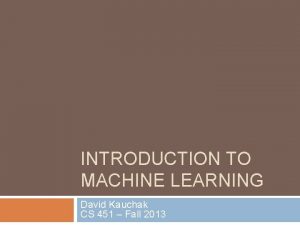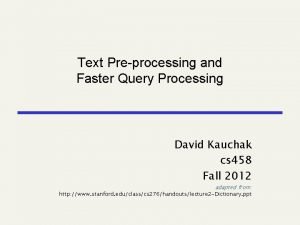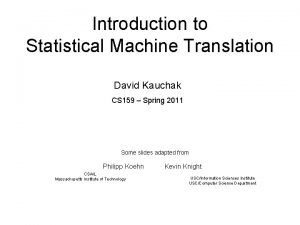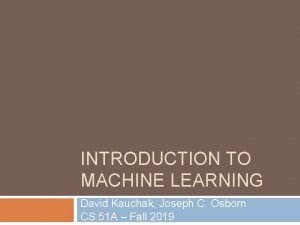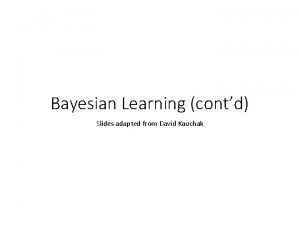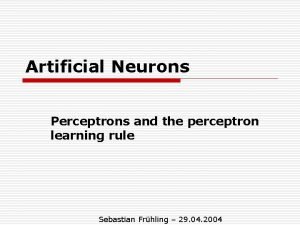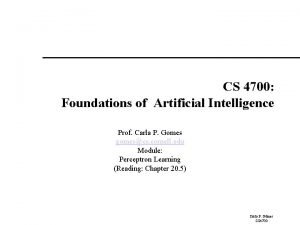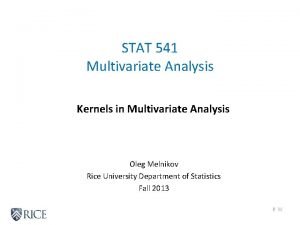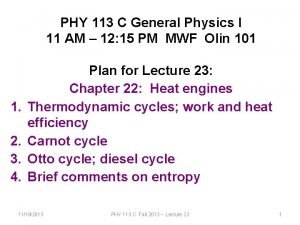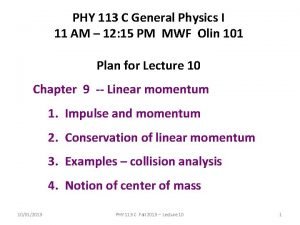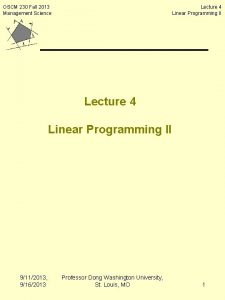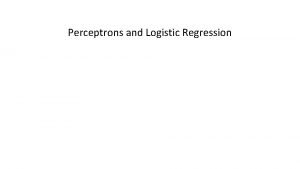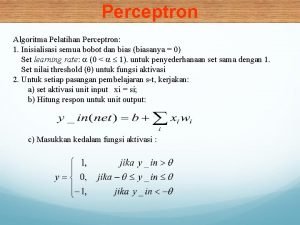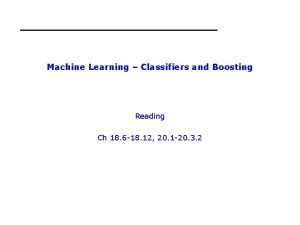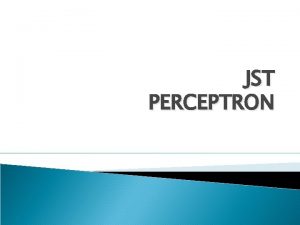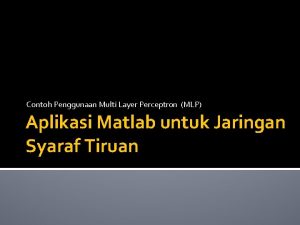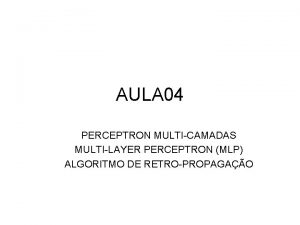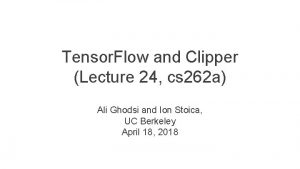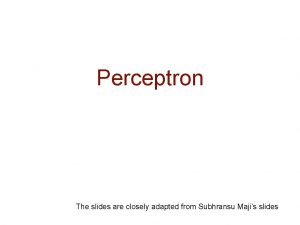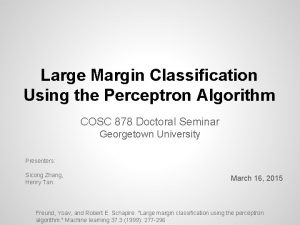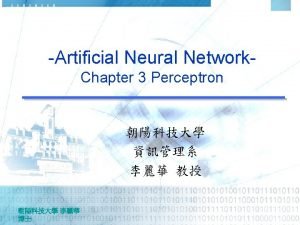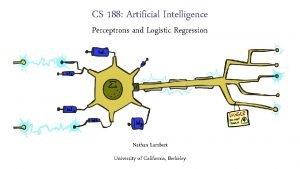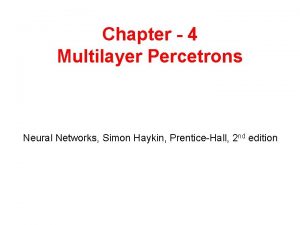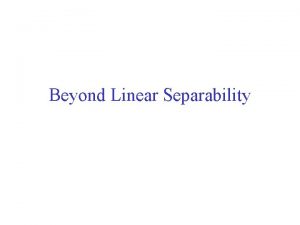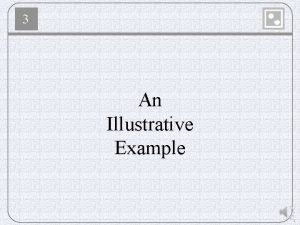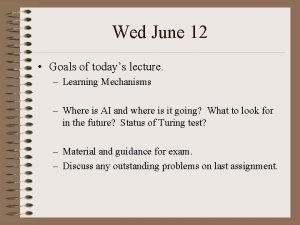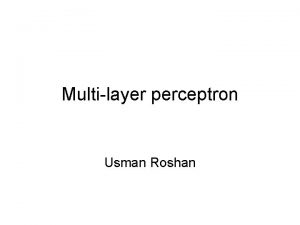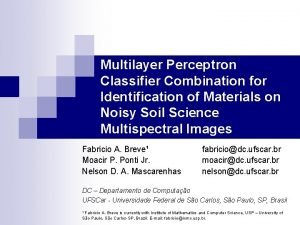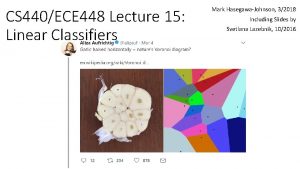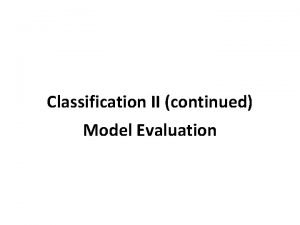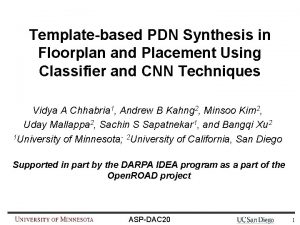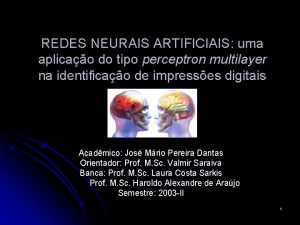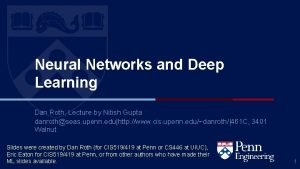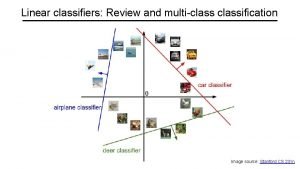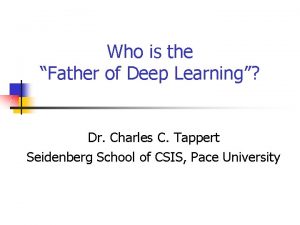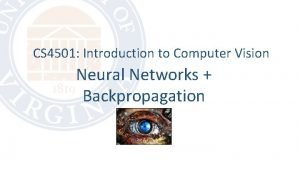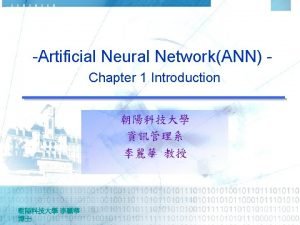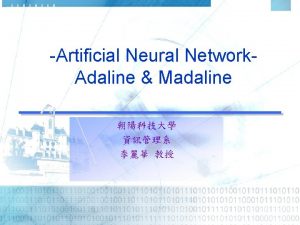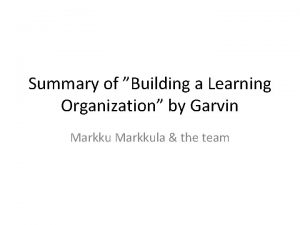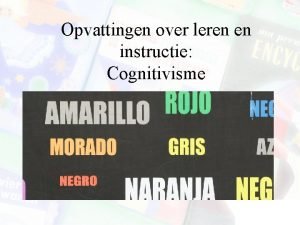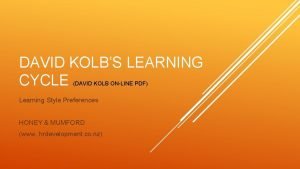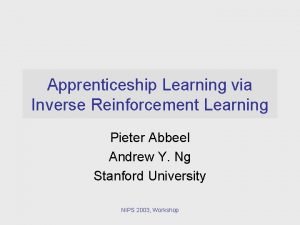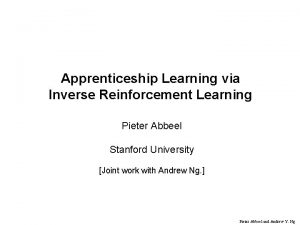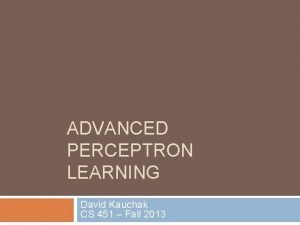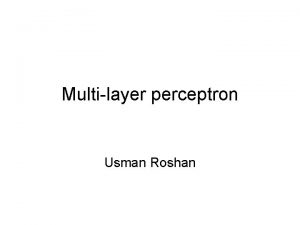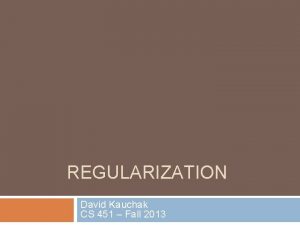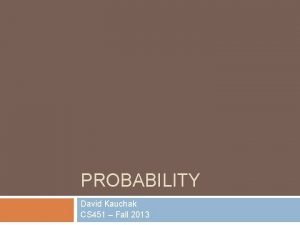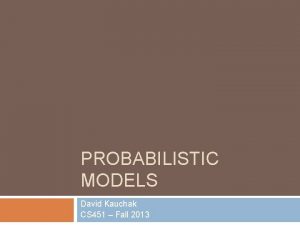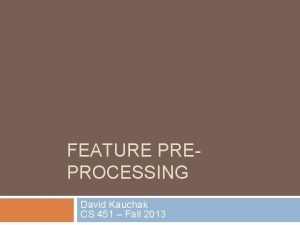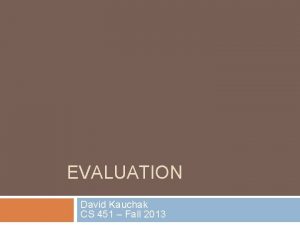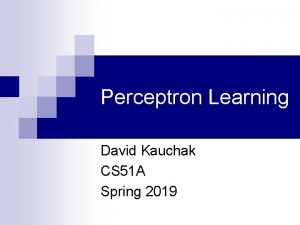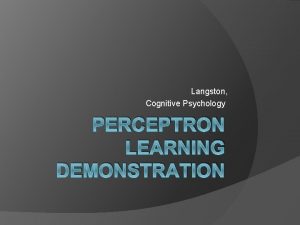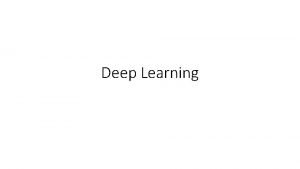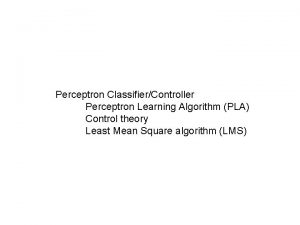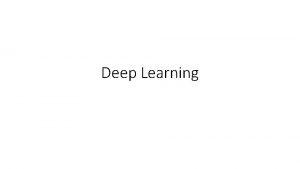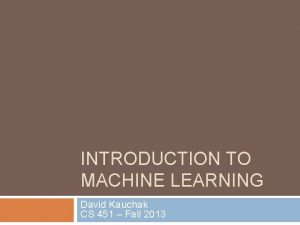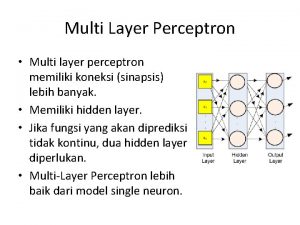PERCEPTRON LEARNING David Kauchak CS 451 Fall 2013







































































- Slides: 71

PERCEPTRON LEARNING David Kauchak CS 451 – Fall 2013

Admin Assignment 1 solution available online Assignment 2 Due Sunday at midnight Assignment 2 competition site setup later today

Machine learning models Some machine learning approaches make strong assumptions about the data � If the assumptions are true this can often lead to better performance � If the assumptions aren’t true, they can fail miserably Other approaches don’t make many assumptions about the data � This can allow us to learn from more varied data � But, they are more prone to overfitting � and generally require more training data

What is the data generating distribution?

What is the data generating distribution?

What is the data generating distribution?

What is the data generating distribution?

What is the data generating distribution?

What is the data generating distribution?

Actual model

Model assumptions If you don’t have strong assumptions about the model, it can take you a longer to learn Assume now that our model of the blue class is two circles

What is the data generating distribution?

What is the data generating distribution?

What is the data generating distribution?

What is the data generating distribution?

What is the data generating distribution?

Actual model

What is the data generating distribution? Knowing the model beforehand can drastically improve the learning and the number of examples

What is the data generating distribution?

Make sure your assumption is correct, though!

Machine learning models What were the model assumptions (if any) that k -NN and decision trees make about the data? Are there data sets that could never be learned correctly by either?

k-NN model K = 1

Decision tree model label 1 label 2 label 3 Axis-aligned splits/cuts of the data

Bias The “bias” of a model is how strong the model assumptions are. low-bias classifiers make minimal assumptions about the data (k-NN and DT are generally considered low bias high-bias classifiers make strong assumptions about the data

Linear models A strong high-bias assumption is linear separability: � in 2 dimensions, can separate classes by a line � in higher dimensions, need hyperplanes A linear model is a model that assumes the data is linearly separable

Hyperplanes A hyperplane is line/plane in a high dimensional space What defines a line? What defines a hyperplane?

Defining a line Any pair of values (w 1, w 2) defines a line through the origin: f 2 f 1

Defining a line Any pair of values (w 1, w 2) defines a line through the origin: f 2 -2 -1 0 1 2 1 0. 5 0 -0. 5 -1 f 1

Defining a line Any pair of values (w 1, w 2) defines a line through the origin: f 2 -2 -1 0 1 2 1 0. 5 0 -0. 5 -1 f 1

Defining a line Any pair of values (w 1, w 2) defines a line through the origin: f 2 (1, 2) w=(1, 2) f 1 We can also view it as the line perpendicular to the weight vector

Classifying with a line Mathematically, how can we classify points based on a l f 2 BLUE (1, 1) f 1 RED (1, -1) w=(1, 2)

Classifying with a line Mathematically, how can we classify points based on a l f 2 BLUE (1, 1): (1, 1) (1, -1): f 1 RED (1, -1) w=(1, 2) The sign indicates which side of the line

Defining a line Any pair of values (w 1, w 2) defines a line through the origin: f 2 f 1 How do we move the line off of the origin?

Defining a line Any pair of values (w 1, w 2) defines a line through the origin: f 2 -2 -1 0 1 2 f 1

Defining a line Any pair of values (w 1, w 2) defines a line through the origin: f 2 Now intersects at -1 -2 -1 0 1 2 0. 5 0 -0. 5 -1 -1. 5 f 1

Linear models A linear model in n-dimensional space (i. e. n features) is define by n+1 weights: In two dimensions, a line: (where b = -a) In three dimensions, a plane: In n-dimensions, a hyperplane

Classifying with a linear model We can classify with a linear model by checking the sign: Positive example f 1, f 2, …, fn classifier Negative example

Learning a linear model Geometrically, we know what a linear model represents Given a linear model (i. e. a set of weights and b) we can classify examples Training Data (data with labels) n r lea How do we learn a linear model?

Positive or negative? NEGATIVE

Positive or negative? NEGATIVE

Positive or negative? POSITIVE

Positive or negative? NEGATIVE

Positive or negative? POSITIVE

Positive or negative? POSITIVE

Positive or negative? NEGATIVE

Positive or negative? POSITIVE

A method to the madness blue = positive yellow triangles = positive all others negative How is this learning setup different than the learning we’ve done before? When might this arise?

Online learning algorithm Labeled data 0 rn a le Only get to see one example at a time!

Online learning algorithm Labeled data 0 0 rn a le Only get to see one example at a time!

Online learning algorithm Labeled data 0 0 1 rn a le Only get to see one example at a time!

Online learning algorithm Labeled data 0 0 1 rn a le 1 Only get to see one example at a time!

Online learning algorithm Labeled data 0 0 1 rn a le 1 … Only get to see one example at a time!

Learning a linear classifier f 2 f 1 What does this model currently say? w=(1, 0)

Learning a linear classifier f 2 NEGATIVEf 1 POSITIVE w=(1, 0)

Learning a linear classifier f 2 (-1, 1) f 1 Is our current guess: right or wrong? w=(1, 0)

Learning a linear classifier f 2 (-1, 1) f 1 predicts negative, wrong How should we update the model? w=(1, 0)

Learning a linear classifier f 2 (-1, 1) f 1 Should move this direction w=(1, 0)

A closer look at why we got it wrong w 1 w 2 (-1, 1, positive) We’d like this value to be positive since it’s a positive value Which of these contributed to the mistake?

A closer look at why we got it wrong w 1 w 2 (-1, 1, positive) We’d like this value to be positive since it’s a positive value contributed in the wrong direction could have contributed (positive feature), but didn’t How should we change the weights?

A closer look at why we got it wrong w 1 w 2 (-1, 1, positive) We’d like this value to be positive since it’s a positive value contributed in the wrong direction decrease 1 -> 0 could have contributed (positive feature), but didn’t increase 0 -> 1

Learning a linear classifier f 2 (-1, 1) f 1 Graphically, this also makes sense! w=(0, 1)

Learning a linear classifier f 2 f 1 Is our current guess: right or wrong? (1, -1) w=(0, 1)

Learning a linear classifier f 2 f 1 predicts negative, correct How should we update the model? w=(0, 1) (1, -1)

Learning a linear classifier f 2 f 1 Already correct… don’t change it! (1, -1) w=(0, 1)

Learning a linear classifier f 2 f 1 Is our current guess: right or wrong? (-1, -1) w=(0, 1)

Learning a linear classifier f 2 f 1 predicts negative, wrong (-1, -1) How should we update the model? w=(0, 1)

Learning a linear classifier f 2 Should move this direction f 1 (-1, -1) w=(0, 1)

A closer look at why we got it wrong w 1 w 2 (-1, positive) We’d like this value to be positive since it’s a positive value Which of these contributed to the mistake?

A closer look at why we got it wrong w 1 (-1, positive) w 2 We’d like this value to be positive since it’s a positive value didn’t contribute, but could have contributed in the wrong direction How should we change the weights?

A closer look at why we got it wrong w 1 w 2 (-1, positive) We’d like this value to be positive since it’s a positive value didn’t contribute, but could have contributed in the wrong direction decrease 0 -> -1 1 -> 0

Learning a linear classifier f 2 f 1, f 2, label -1, positive -1, 1, positive 1, 1, negative 1, -1, negative f 1 w=(-1, 0)
 David kauchak
David kauchak Lebensversicherungsgesellschaftsangestellter
Lebensversicherungsgesellschaftsangestellter David kauchak
David kauchak Translation process
Translation process David kauchak
David kauchak David kauchak
David kauchak David kauchak
David kauchak Introduction to teaching
Introduction to teaching Perceptron learning rule
Perceptron learning rule Perceptron learning algorithm
Perceptron learning algorithm Fall 2013
Fall 2013 Fall 2013
Fall 2013 Collision physics
Collision physics Fall 2013
Fall 2013 Cuadro comparativo e-learning b-learning m-learning
Cuadro comparativo e-learning b-learning m-learning Marc vrakking
Marc vrakking Perceptron logistic regression
Perceptron logistic regression Contoh soal perceptron
Contoh soal perceptron Threshold logic unit
Threshold logic unit Perceptron classifier
Perceptron classifier Contoh soal perceptron or
Contoh soal perceptron or Multilayer perceptron matlab
Multilayer perceptron matlab Teorema da aproximação universal
Teorema da aproximação universal Perceptron excel
Perceptron excel Perceptron xor
Perceptron xor Perceptron
Perceptron Perceptron multicouche python
Perceptron multicouche python Large margin classification using the perceptron algorithm
Large margin classification using the perceptron algorithm Perceptron 1957
Perceptron 1957 Perceptron-based prefetch filtering
Perceptron-based prefetch filtering Mlp
Mlp Cs 188
Cs 188 Neural networks simon haykin
Neural networks simon haykin Limitations of perceptron:
Limitations of perceptron: Perceptron sorter
Perceptron sorter Perceptron convergence theorem proof
Perceptron convergence theorem proof Multilayer perceptron
Multilayer perceptron Multilayer perceptron
Multilayer perceptron Perceptron
Perceptron Import pandas as pd
Import pandas as pd Perceptron
Perceptron In matlab
In matlab Pdn
Pdn Perceptron
Perceptron Hidden layer perceptron
Hidden layer perceptron Computation history
Computation history Stanford
Stanford Frank rosenblatt
Frank rosenblatt From sklearn.linear_model import perceptron
From sklearn.linear_model import perceptron Perceptron advantages disadvantages
Perceptron advantages disadvantages Perceptron
Perceptron Difference between adaline and perceptron
Difference between adaline and perceptron Difference between adaline and madaline
Difference between adaline and madaline 2013 cci learning
2013 cci learning Cengage learning 2013
Cengage learning 2013 Building a learning organization by david a. garvin
Building a learning organization by david a. garvin Subsumption theory example
Subsumption theory example Advance organizer betekenis
Advance organizer betekenis Kolbs learning styles
Kolbs learning styles Supervised learning dan unsupervised learning
Supervised learning dan unsupervised learning Concept learning task in machine learning
Concept learning task in machine learning Analytical learning in machine learning
Analytical learning in machine learning Define non associative learning
Define non associative learning Eager classification versus lazy classification
Eager classification versus lazy classification Define conceptual learning
Define conceptual learning Difference between inductive and analytical learning
Difference between inductive and analytical learning Apprenticeship learning via inverse reinforcement learning
Apprenticeship learning via inverse reinforcement learning Apprenticeship learning via inverse reinforcement learning
Apprenticeship learning via inverse reinforcement learning Every quiz has been easy. therefore, the test will be easy.
Every quiz has been easy. therefore, the test will be easy. Pac learning model in machine learning
Pac learning model in machine learning Pengertian unsupervised learning
Pengertian unsupervised learning Machine learning t mitchell
Machine learning t mitchell
